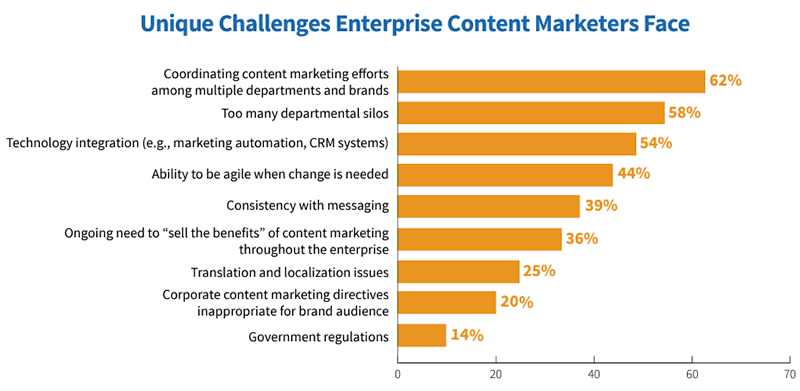When interacting with a brand and their messaging is all over the place, you probably get turned off, no matter the actual words or the brand saying them. It creates unease and erodes trust, something of which no business wants to be the bearer. Maintaining consistent brand messaging is critical for enterprise content marketing.
There are challenges — multiple channels, products, and audiences — that can threaten consistency even if well documented in your content strategy and content plan. Alignment is something in which enterprise content teams struggle within and with other departments. The 2020 Enterprise Content Marketing report from the Content Marketing Institute (CMI) revealed:
- 62% of marketers said coordinating content marketing efforts among multiple departments and brands was a unique challenge.
- 39% said consistency in messaging was a challenge.
Image Source: Content Marketing Institute
So, what’s the path to overcoming these challenges?
What Does Message Consistency Mean?
First, let’s talk about the term “message consistency.” It describes alignment across all the content you produce that takes its core messaging from your brand language (e.g., unique selling proposition, elevator pitch, and value proposition), the audience you serve, and the challenges your company solves.
It doesn’t mean using the same words redundantly through every channel. Consider it a foundation that gets tweaks, depending on:
- The channel: White paper messaging and social media messaging are different in tone but can generally call back to your core value prop.
- Audience: You likely have multiple buyer personas, each needing a personalized message.
- The product or service: Enterprises promote a portfolio of products or services, so there are differences here as well.
- The content goal: Each piece of content has a unique goal, which influences messaging.
- The buying stage: Across each part of the funnel, the messaging transitions as customers get closer to conversion.
- The topic: The content you create highlights various challenges and needs, requiring fine-tuned messaging for each.
Let’s look at a few examples to define the concept better.
Message Consistency: Brands That Hit the Mark
Here are some examples that bring the idea to life. Some of these brands you’ll know; others are under the radar.
Zocdoc
Zocdoc is an online solution for consumers to find and book appointments with local medical professionals. In a digital world, many patients avoid making healthcare visits because it’s too hard and cumbersome. Zocdoc gets this and understands that many people could be very nervous about finding a physician.
They drive home consistent brand messaging around ease, convenience, and helpfulness. The design style they use — warm and fuzzy illustrations — also carries that same tone.
Image: Zocdoc
Geico
Geico is an expert at fun, charming, and hilarious content themes. No matter if it’s content about Mr. Gecko or cameos from unexpected guests, Geico always goes back to the key message of being a quick way (15 minutes) to save on your car insurance.
They’ve become a pop culture phenomenon with millions of YouTube subscribers. Check out one of their newest ads below.
Semrush
Semrush is a well-known SEO (search engine optimization) platform. Their audience is much like ours — content marketing professionals. They cover many topics within the SEO and SEM (search engine marketing) realm, but they have consistent brand messaging focused on empowering and enabling marketers to rank better. Their blog is a great example of multiple subjects with a holistic message.
So, why does message consistency matter? The benefits are worth making it a priority.
Benefits of Message Consistency
If you need reasons to get the organization on board with message consistency, these benefits should be at the top of your list.
Consistency Down the Funnel
Buyers consume a lot of content as they flow through the buying funnel. They’ll read and interact with multiple pieces before they decide to connect. Without consistent messaging, they’re more likely to exit the funnel.
Consistency Makes You Memorable
Going back to the Geico example above, you can bet most people know their motto, whether they are customers or not. You may not reach that level of notoriety, but staying on track improves recall. People must see, read, or hear things at least seven times before recalling them.
Remaining on point within all your content increases the ability of the prospect to remember you when they’re ready to purchase.
Maintaining Consistency Creates Trust
When your brand is “true” to its roots, messaging is reliable and trustworthy. One of the most critical connections between your company and customers is trust. Without it, most would have little consideration for your organization. Build this type of trust by walking the walk.
These benefits are enterprise-wide, but you’ll need to overcome consistency challenges to achieve them.
Challenges with Message Consistency
When it comes to operationalizing message consistency, these are the most common obstacles.
- Misalignment internally due to a lack of standardization: The first issue is the biggest. Everyone can’t stay on the same page if there is no page! You must document core messaging in your voice and tone within your content strategy. Only then can you get on the same path.
- Team structure could impact consistency: Often, silos exist in enterprise content teams due to structural issues that keep people from collaborating effectively. You’ll need to remove these and define the parameters to ensure that content production isn’t occurring in a vacuum.
- Misdirection from leadership: If senior-level executives have their hands in content, that’s not always a good thing. They may have ideas about messaging that are off-key because of their bias and knowing everything about your product or service. You may not be able to eliminate this influence, but educate these stakeholders with your strategy and planning documents.
- Failures in content workflows: Enterprise content production is constantly increasing. Without workflows and technology, message consistency can suffer because tasks fall through the cracks or other brand checks don’t occur.
To resolve many of these, you’ll find that technology is critical. Other tools can also help, like developing a documented messaging matrix that can be referenced by all content producers.
Technology Lends a Helping Hand to Maintain Consistent Brand Messaging
A content marketing platform like DivvyHQ is a crucial tool to support enterprise marketers and message consistency. With a dynamic content calendar, flexible content workflows, centralized repositories, and access to brand language, you can improve content operations and consistency. These tools can support all your enterprise content marketing needs. See how it works today by trying it for free.


